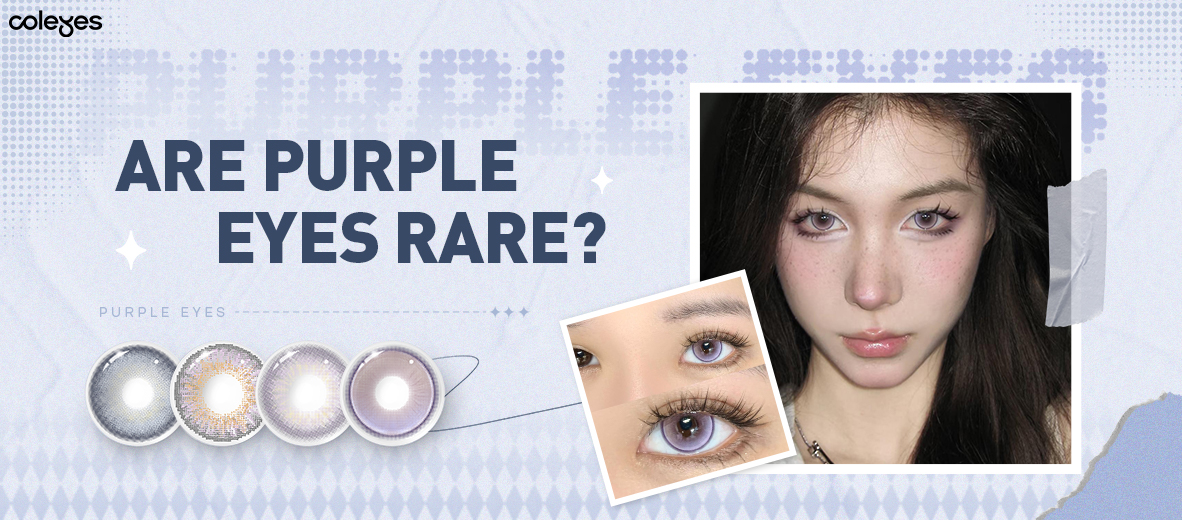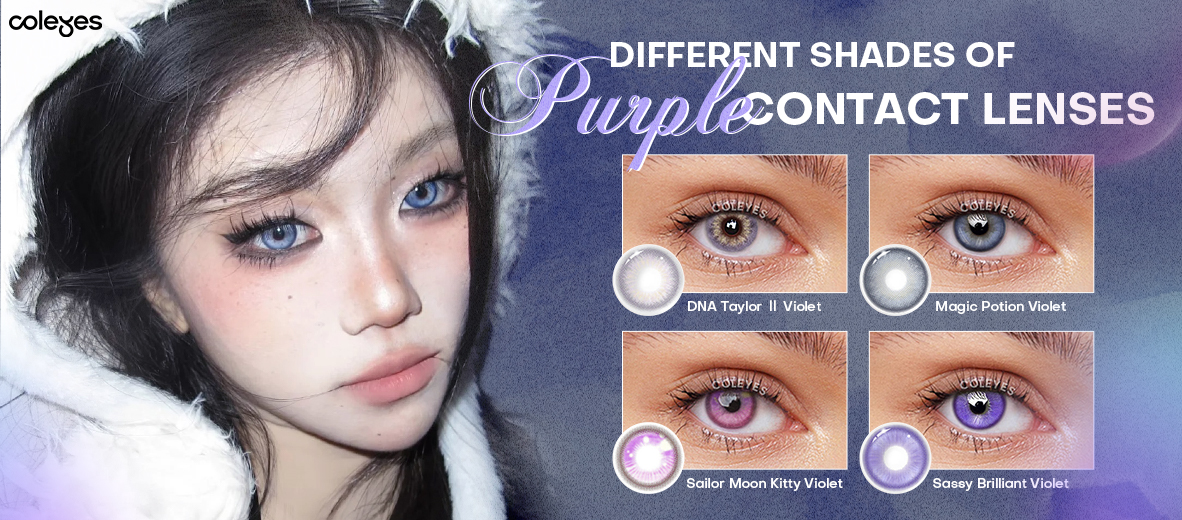Understanding the Rarity of Purple Eyes
May 15,2024 | Coleyes

Thinking of purple eyes might evoke images of fantasy characters, but could they exist in reality? Surprisingly, the answer is yes, though extremely rare. In this article, we explore the genetic anomaly behind purple eyes, evaluate historical claims, and shine light on how some individuals may possess this startling iris color.
Purple eyes, known as natural violet eyes, are incredibly rare and account for less than 1% of the global population. This rarity is often associated with genetic variations or conditions such as different forms of albinism which influence the pigmentation within the iris.
The formation of purple eyes can be due to genetic mutations such as a mutation in the FOXC2 gene, or from eye conditions like uveitis where inflammation can change the appearance of the eye’s color. These cases can sometimes also be accompanied by health conditions or symptoms that affect vision.
While natural purple eyes are exceedingly rare, their cultural significance and desirability have been cemented through historical associations with royalty, mystique, and popular culture portrayals. For those seeking the purple eye aesthetic, colored contact lenses are available, but safety and proper use should be emphasized to prevent any eye health issues.
Unveiling the Mystery of Purple Eyes
Purple eyes, also known as natural violet eyes, are a marvel of nature, a rarity that captivates and intrigues. They are a genetic masterpiece, an extraordinary mutation that makes them a unique sight among the more common blue, green, and brown eyes. Yet, their rarity is not their only allure. Individuals with violet or purple eyes, just like blue eyed people, are often associated with an air of mystery, exuding an irresistible allure and a hint of power and intelligence. The purple irises of these individuals truly set them apart.
However, don’t be fooled by the captivating charm of these violet beauties. Their existence does not imply perfection or supernatural abilities. Instead, they add an intriguing element to the individual’s beauty, a touch of mystery that sets them apart from the crowd. So, what’s the science behind these alluring eyes? Let’s take a closer look.
The Science Behind Eye Color
Eye color, a characteristic that distinguishes us from one another, is primarily determined by the pigment melanin located in the iris. The amount of melanin present and how it’s distributed, influenced by multiple interacting genes, creates the diverse palette of eye colors we see in people around us. Some examples of eye colors and their characteristics are:
-
Brown eyes: contain a high concentration of melanin
-
Blue eyes: have significantly less melanin
-
Green eyes: have an amount of melanin in between brown and blue eyes.
In some instances, the eyes can even appear purple. This fascinating phenomenon is often observed in individuals with lower melanin levels. When light reflects off their red blood vessels, their eyes can appear to have a purple hue. But the color spectrum of purple eyes doesn’t stop there. Let’s take a closer look at the different shades of purple eyes.
Different Shades of Purple Eyes
Just as the sky at dusk presents a spectrum of colors, including dark blue, purple eyes come in a variety of shades. Some examples include:
-
Subtle grey-purple that whispers of mystery
-
Vibrant blue-purple that shouts of intrigue
-
Unique shade of pink-purple, giving their eyes a lighter and more distinctive hue.
These diverse shades of purple eyes add depth to their allure and contribute to their rarity. Yet, they are so uncommon that you might wonder, how rare are purple eyes exactly?
Are Purple Eyes Rare?
Purple eyes are more than just rare; they are an exception in the human population. Making up less than 1% of the global population, individuals with purple eyes can be considered a genetic rarity. To put it into perspective, amber eyes, which can sometimes appear similar to purple, represent about 5% of the world’s population. This emphasizes just how rare true purple eyes are.
Most often, the occurrence of true violet-colored eyes is associated with forms of albinism, a genetic condition that affects the production of melanin, the pigment that gives color to our hair, skin, and eyes. Let’s explore this connection further.
The Connection Between Albinism and Purple Eyes
Albinism, a genetic condition that affects the production of melanin, can result in a spectrum of eye colors, with purple eyes being one of them. Low melanin levels in the iris, often associated with albinism, can cause eyes to appear purple. However, not all individuals with albinism have purple eyes; their eyes can exhibit a range of colors including:
-
blue
-
hazel
-
brown
-
and, in rare cases, violet.
Despite the connection between albinism and purple eyes, the rarity of purple eyes is compounded by the low occurrence of albinism, which affects about 1 in 20,000 people in the U.S. So, how exactly does albinism affect melanin production and lead to such a wide range of eye colors?
Albinism and Melanin Production
In individuals with albinism, the production of melanin is affected due to genetic defects, specifically reduced or absent activity of the tyrosinase enzyme crucial for melanin production. These varying levels of melanin production influence not just the color of their eyes but also their hair pigmentation, including body hair. The less melanin produced, the lighter their hair color, ranging from white to light blonde, and sometimes brown or red, as opposed to dark skin individuals. This also results in light skin for those affected by albinism.
When it comes to eye color, the altered melanin production affects the iris, often resulting in very light blue eyes or other variations influenced by the amount of melanin in the iris. However, in some instances, albinism can result in a specific type known as ocular albinism.
Ocular Albinism
Ocular albinism, a specific type of albinism, affects iris color and vision. Individuals with this condition produce less melanin, leading to vision complications, as melanin is crucial for the development of the retina. This type of albinism often results in lighter iris pigmentation compared to unaffected family members, contributing to distinctive eye color variations which may sometimes appear purple.
Inherited in an X-linked pattern, ocular albinism is more common in males, while females may carry the gene without displaying symptoms. Yet, there are other genetic factors that can contribute to the development of purple eyes, such as the FOXC2 gene mutation.
Genetic Mutations and Purple Eyes
Genetic mutations can also result in the mesmerizing color of purple eyes. One such genetic mutation is in the FOXC2 gene, which can lead to a bluish-purple hue of the eyes. However, the exact genetic mechanism leading to natural purple eyes remains largely uncharacterized beyond this specific gene mutation.
While these mutations are a potential cause of natural purple eyes, it’s important to note that they may also be associated with other health conditions. Let’s explore the FOXC2 gene mutation and one such condition, lymphedema-distichiasis syndrome, in more detail.
FOXC2 Gene Mutation
The FOXC2 gene plays a crucial role in the development of various physical traits, including eye color. When this gene undergoes a mutation, it can result in the production of less pigment in the eyes, resulting in a bluish-purple hue. This distinct eye color contributes to the rarity of purple eyes in the human population.
Despite the captivating beauty of these bluish-purple eyes, the FOXC2 gene mutation is not without its complications. It can result in a rare genetic condition known as lymphedema-distichiasis syndrome.
Lymphedema-Distichiasis Syndrome
Lymphedema-distichiasis syndrome is a rare genetic condition that arises from mutations in the FOXC2 gene. One of the striking features of this syndrome is a unique blue-purple eye coloration. However, this syndrome is also associated with distichiasis, a condition where a second row of eyelashes grows, leading to complications such as eye irritation, increased tearing, and potential impairments to vision.
The severity and range of symptoms associated with lymphedema-distichiasis syndrome vary significantly among affected individuals, with differences often observed even among members of the same family. However, apart from genetic mutations, inflammation within the eye can also result in the appearance of violet eye color. Let’s explore one such case of uveitis.
Inflammation and Purple Eyes: The Case of Uveitis
Uveitis, a form of eye inflammation, can cause an alteration in eye color, including giving the eye a purple appearance. This eye condition affects the uvea layer, which can cause changes in the structure of the eye’s tissues and blood vessels, potentially leading eyes to appear purple.
While purple eyes can be the result of uveitis, they also indicate potential risks and complications, such as further damage to the eye’s delicate structures. So, how does uveitis cause a change in eye color, and what risks and complications are associated with it?
Uveitis and Eye Color Change
Uveitis can precipitate abrupt symptoms like eye redness, pain, and alterations in vision, which can be perceived as a purple discoloration of the eyes. In some cases, such as Fuchs uveitis syndrome, the inflammation can result in an eye color change, leading the eyes to sometimes appear blue or purple, a condition often referred to as purple eye syndrome.
The inflammation from uveitis can cause changes in the eye’s appearance, including giving the eye a purple appearance. It’s important to be aware that the eyes turning purple could be an indication of this inflammatory condition, which can bring potential risks and complications.
Risks and Complications
Uveitis is a severe eye condition that can lead to blindness due to the destruction of eye tissues, including the retina and iris. The inflammation primarily affects the uvea and can also impact other eye structures such as the lens, retina, optic nerve, and vitreous, leading to alterations in eye color, including a purple appearance.
Symptoms of uveitis include eye pain, sensitivity to light, and vision disturbances, which could manifest in changes to eye color, including a purple appearance.
Management options for uveitis include steroid drops and the Retisert implant, which help to reduce inflammation, manage symptoms, and preserve eyesight.
The Cultural Impact of Purple Eyes
Purple eyes carry a cultural significance that transcends their genetic rarity. Throughout history, they have been associated with:
-
Royalty
-
The divine
-
Nobility
-
Power
-
A connection to the spiritual realm
Their presence in folklore and mythology further enhances their allure and mystery.
Elizabeth Taylor's Iconic Eyes
One of the most well-known figures associated with purple eyes is Elizabeth Taylor. However, contrary to popular belief, Elizabeth Taylor’s eyes were actually blue, not purple. Yet, her striking eyes were often perceived as purple due to external factors like lighting, makeup, and clothing, which enhanced the blue in her eyes to appear more violet.
Photography also played a role in perpetuating the myth of Elizabeth Taylor’s purple eyes. The camera often captured her eyes as more violet or purple than they naturally were, contributing to her iconic image and the fascination with purple eyes.
Purple Eyes in Popular Culture

Purple eyes have made their mark in popular culture as well. Often, characters with purple eyes are depicted as mysterious or powerful, further enhancing the mystique and allure of this extraordinary eye color.
Whether it’s in books, movies, or video games, the appearance of a character with purple eyes always adds an element of intrigue and fascination, solidifying the cultural impact of purple eyes. But if you’re captivated by these vibrant violet hues and wish to have purple eyes yourself, there’s a modern solution.
Achieving Purple Eyes with Contact Lenses
In the modern era, achieving the look of purple eyes is easier and more accessible with the help of colored contact lenses. Whether you’re looking to dazzle at a party, stand out in a crowd, or just enjoy the mystique of purple eyes, colored contacts can help you achieve that look. But remember, safety should always be a priority when it comes to your eyes.
Types of Colored Contacts
Purple contact lenses come in various colors, patterns, and styles, offering a wide choice in tones for different effects, suitable for both dark and light eyes. Whether you need vision correction or not, both prescription and non-prescription versions of purple contacts are available.
These colored contacts can be purchased for varying durations of wear, including daily disposable, 90-day, and annual replacement schedules. From those mimicking natural iris patterns to dramatic effects for costumes, there’s a design of purple contacts for every preference.

Safety Considerations
However, as exciting as the prospect of transforming your look with purple contact lenses may be, it’s crucial to understand the safety considerations. Colored contacts need to be specifically fitted to an individual’s eyes by an eye care professional to minimize risks.
To wear colored contacts safely, it is essential to get an eye exam, a proper prescription, never share lenses with others, and dispose of the lenses after their expiry date. Improper use of contact lenses can lead to eye health issues, such as scratching the cornea or restricting oxygen flow to the eye.
Summary
From genetic mutations and albinism to inflammation and colored contact lenses, this journey through the world of purple eyes has unveiled the truth behind this rare and captivating phenomenon. As we’ve explored, purple eyes, while exceptionally rare, are a fascinating manifestation of our genetic diversity. They stand as a testament to the marvels of nature and the mysteries of human genetics. So, the next time you spot a pair of mesmerizing purple eyes, you’ll know the captivating science and history behind them.
Can purple eyes be achieved with contact lenses?
Yes, colored contact lenses can help achieve purple eyes effectively.



